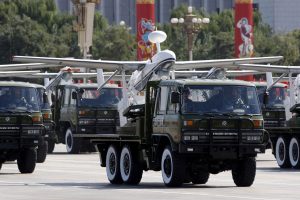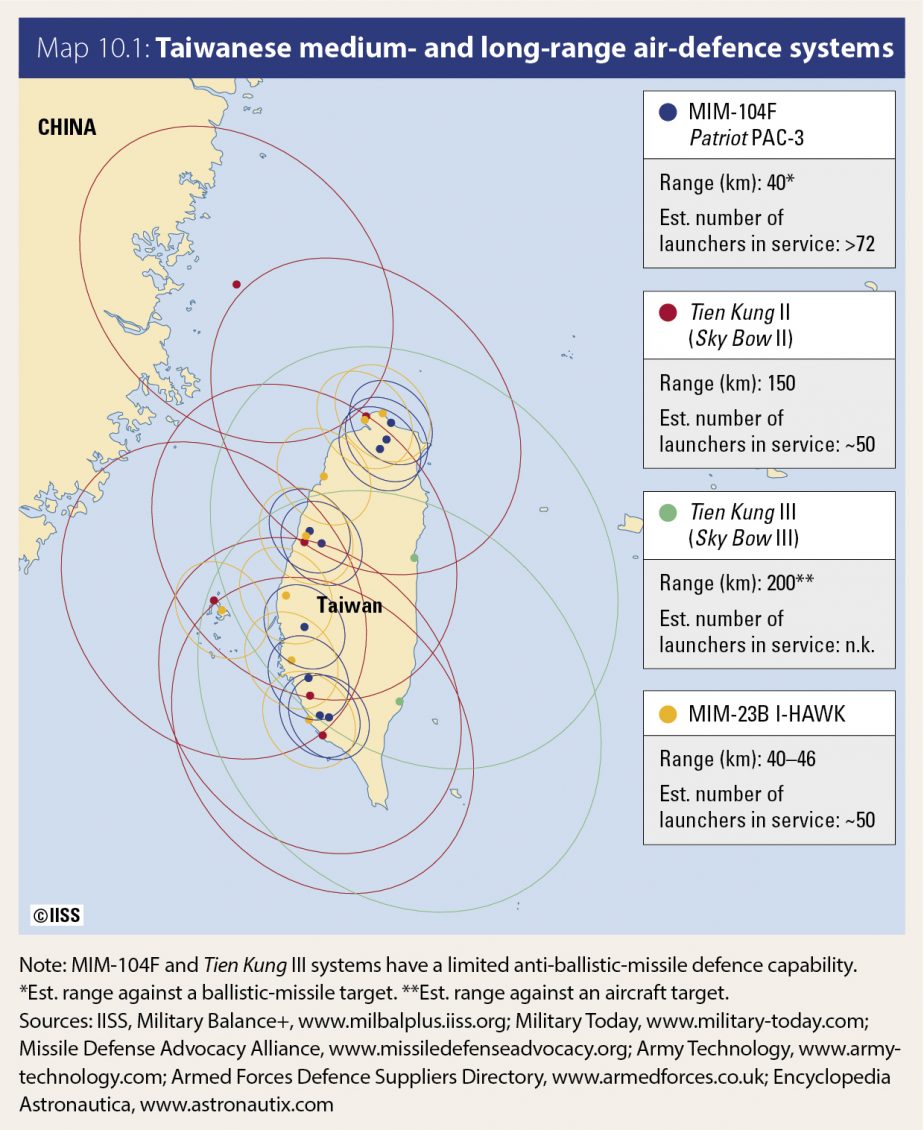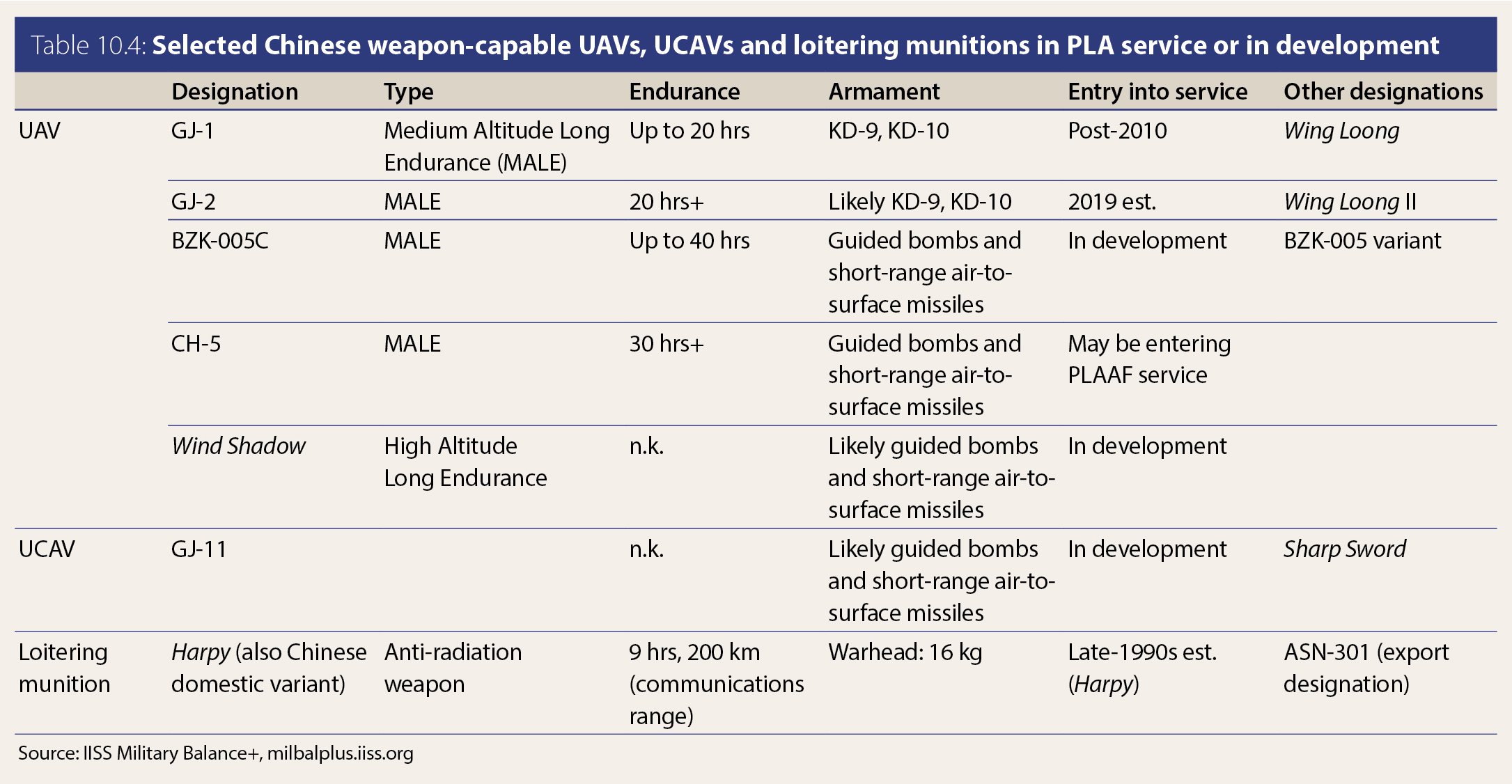By Franz-Stefan Gady

The question as to whether Taiwan can or should be defended by the United States in the event of Chinese military aggression has caused considerable debate in recent months within the U.S. defense and foreign policy communities. Discussions on this subject have been made more difficult as a result of emerging military technologies, especially in artificial intelligence (AI), cyber, robotics, and hypersonic systems, and questions about how they will impact both the quantitative and qualitative cross-strait military balance between China and Taiwan, as well as between China and the United States.
To help better understand the potential impact of these technologies on military power in East Asia, this short article aims to present a distinct scenario involving possible future military conflict between the United States and China over Taiwan in 2030. The scenario discussed below involves the Chinese People’s Liberation Army’s (PLA) employment of unmanned-aerial-vehicle (UAV) swarms to degrade Taiwanese air-defense systems, and unmanned underwater vehicles (UUVs) to target a U.S. Navy carrier strike group (CSG) in the Philippine Sea. The fictitious scenario in 2030 describes the emerging technological capabilities alongside novel operating concepts and highlights the role of senior decision-makers in determining the character of future conflict. A second section of the article aims to analyze the emerging technological capabilities’ current state of development in China. It should be understood that the scenarios are meant to be illustrative of emerging technological capabilities, operational concepts and leadership choices rather than resolving real political problems or predicting the character and place of actual warfighting in the 2030s.
2030 Scenario: Chinese Unmanned Platforms Degrading Taiwanese Air Defenses and Disabling a U.S. Navy Carrier
The chief of the Joint Staff Department of China’s Central Military Commission was pleased. For the past decade, the chief had been advocating for the more aggressive use of unmanned platforms, both in the air and at sea, but had faced an uphill battle against the “traditionalists,” who insisted that manned aircraft and ships should continue to take the lead in offensive operations. Now, on the third day of China’s war with Taiwan and the United States, the chief’s push for unmanned platforms appeared vindicated because of the almost simultaneous messages received at their headquarters: People’s Liberation Army Air Force (PLAAF) UAVs and People’s Liberation Army Navy (PLAN) UUVs had succeeded, respectively, in knocking out Taiwanese medium- to long-range air defenses and putting the United States’ Ford-class carrier, USS Enterprise, out of action in the Philippine Sea.
The PLAAF had unleashed almost 200 upgraded variants of the GJ-11 unmanned combat aerial vehicle (UCAV), variously fitted with ISR, electronic warfare, and weapon payloads, against Taiwan’s 40 medium- and long-range air-defense batteries. This was the last stage of the PLAAF’s “suppression of enemy air defense” operating concept, adopted in 2028. The UCAV attack was preceded by coordinated ballistic missile and cruise missile attacks, including the use of hypersonic missiles, against Taiwanese command-and-control nodes, and offensive cyber operations that temporarily degraded Taiwanese radar space-based ISR satellite systems.
The Joint Staff Department chief had pushed for the Hongdu GJ-11 and other equivalent UCAVs to enter serial production in 2022, as well as for the opening of a second GJ-11 production line under the 15th Five-Year Plan, in order to reach the goal of 200 operational long-range UCAVs by 2030. These “dispensable” platforms had now proved their worth. Multiple swarms of roughly a dozen UCAVs each − with each swarm controlled by a single PLAAF operator via satellite links − attacked all of Taiwan’s surviving MIM-104 Patriot, MIM-23 Hawk, and Tien Kung II and III SAM missile companies.
The more sensational news, however, came from the Philippine Sea, where the USS Enterprise had been put out of action by a swarm of armed UUVs – converted semi-autonomous Yu-9 heavy- weight torpedoes, fitted with AI-enabled sensors – launched from two PLAN Type-093A (Shang II) nuclear-powered attack submarines (SSN). Each SSN had launched over a dozen UUVs well beyond the sensor ranges of the Enterprise Carrier Strike Group (CSG) CSG escort vessels and aircraft. The UUVs were programmed to loiter in the projected transit routes of the CSG in the Philippine Sea, based on data provided by a web of seabed sensors and prepositioned communication buoys planted by the PLAN over the previous decade along the sea approaches to Taiwan.
The chief of the Joint Staff Department had been a strong advocate of “smart minefield” operating concepts, consisting of submarine-launched UUVs loitering for weeks in target areas or in shallower waters sinking to the seabed to await activation, and then − upon receiving a strike order − attacking their targets in swarms. To expedite their deployment, the chief had advocated conversion of existing weapons systems – Yu-9 heavyweight torpedoes – into UUVs. Such a UUV swarm had penetrated the CSG’s layered defenses, overwhelming its kinetic and non-kinetic anti-UUV defenses, with two UUVs sinking an Arleigh Burke-class guided-missile destroyer, and two other UUVs hitting and disabling the Enterprise’s four 30-tonne propellers, thereby rendering the carrier hors de combat. While the U.S. Navy had developed countermeasures that might have been expected to defeat the reconfigured torpedoes, the PLA had scored a massive espionage coup against the private U.S. corporation developing the countermeasures package, and was able to neutralize it.
State of Emerging-Technology Developments in 2021: Chinese UAVs
China’s 2019 defense white paper emphasized that “there is a prevailing trend to develop long-range precision, intelligent, stealthy or unmanned weaponry or equipment.” However, UAV swarm technology – defined as a team of drones operating collectively, interacting with each other and working toward a common goal – remains at an embryonic stage of development and is unlikely to affect the battlefield substantially in the near term. China has been developing and producing both unarmed ISR and armed UAVs for two decades. A 2018 paper by the Beijing Joint Armaments Technology Academy on UAV System Development set the specific goal for China’s defense industry to become a global leader in military UAV technology by 2035. China’s 14th Five-Year Plan (2021-25) also emphasizes the development of new UAV capabilities and technology.
In September 2020, China tested a large “suicide drone” formation of up to 200 UAVs in a simulated combat environment. The UAVs (resembling the CH-901 loitering munition) were deployed by the China Academy of Electronics and Information Technology from an array of tubular launchers. Similar tests were carried out in 2017, involving over 100 UAVs undertaking reconnaissance duties in synchronization. China reportedly intends to deploy UAV swarms from warships, ground vehicles, helicopters, and bombers. Institute for International Strategic Studies (IISS) research indicates that China’s defense industry is developing or producing more than 20 different UAV/UCAV variants, with at least 15 of these capable of reaching and operating over Taiwan from the Chinese mainland. The GJ-11, the stealth UCAV mentioned in the 2030 scenario, has reportedly been undergoing testing and evaluation with the UAV testing unit of the PLAAF, 178th Brigade, at Malan airfield in Xinjiang province in western China.
Current UAV development in China and PLA writing on the use of UAVs in future conflict together suggest that the PLA is considering using UAVs for a wide range of missions, including ISR, airborne early warning, strike, loyal wingman (involving a semi-autonomous/autonomous UAV supporting manned aircraft), and cyber and electronic warfare roles. Chinese PLA writing has focused especially on the offensive use of UAV swarms. According to an analysis by two Chinese military strategists, UAV swarms can carry out “omnidirectional defense penetration” and execute multidirectional, saturated combined attacks that may produce cyber, electronic and kinetic effects.
State of Emerging-Technology Developments in 2021: Chinese UUVs
There is little publicly available information on Chinese military UUV programs. In 2019, for the first time the PLAN revealed a UUV, designated HSU001 and apparently tailored for underwater ISR missions. However, HSU001 could also carry armed payloads. While the Yu-9 torpedoes might seem an unlikely candidate for inclusion in this category, there is a trend toward electronic propulsion in torpedoes, which would provide longer range and endurance, making them more UUV-like and more capable of a long-term, loitering-munition (i.e., mine) deployment.
Technical challenges to the successful deployment of UUVs and UUV swarms are manifold. For instance, it is necessary to overcome a host of communication and navigation challenges in order to deploy offensive UUVs against surface warships. Acoustic underwater transmission suffers from latency and low bandwidth and is also highly detectable by an adversary, while optical communication is limited to short ranges. It is also still unclear to what degree AI-enabled operating systems could effectively coordinate UUV swarms in a highly complex operating environment without human supervision. Current battery technology would also make the kind of extensive UUV deployments envisaged in the 2030 scenario very difficult. PLAN UUV development overall appears to still lag behind efforts in the U.S. and other Western countries.
China’s expanding unmanned ocean network, as well as its recent deployment of various autonomous underwater gliders, appears to confirm the PLA’s growing interest in unmanned platforms. Besides China’s ongoing oceanographic activities, the PLAN’s traditional emphasis on mine warfare − a means to offset Western naval superiority asymmetrically − may offer insights into future PLAN UUV operating concepts and doctrine. While in Western navies, discussions around the deployment of UUVs have focused on ISR, anti-submarine warfare, mine countermeasures, and logistics, the PLAN could adopt a more kinetic approach by accelerating the R&D of ways to convert existing heavyweight torpedoes into “smart weapons,” which could form the nucleus of autonomous minefields by 2030. The PLAN is likely closely following the discussion outside China about the combined operations of UUVs and crewed sub-surface assets. As early as 2020, the United States had declared that its sub-surface combat capability could not be reliably assessed simply by looking at its submarine count.
In addressing the military challenges of use of force against Taiwan, the PLA has always paid most attention to disabling U.S. CSGs. Since China’s most important military objective is early success in a military campaign against Taiwan − and its most important targets in this campaign would be U.S. CSGs − this mission set could well be the most likely to produce strategic surprise with regard to the development of new weapons and associated tactics from the PLA. Advancements in acoustic communications, navigation, and autonomy are accelerating, with new capabilities coming online all the time.
Conclusion
The scenario explored in this article illustrates two main points. First, it underlines the importance of various interacting factors that will shape the outcome of future military conflict, including personal initiative by military or political leaders; novel operating concepts and doctrine; flexible force structure; and new technological capabilities. Second, as a corollary, the scenario aims to challenge any technological determinist narrative on future conflict. Being a technological leader in 4IR technologies will not automatically translate into military success in the future battlespace. In fact, overreliance and trust in technological superiority at the expense of the aforementioned factors may prove to have the opposite effect.
Lastly, a word of caution is necessary. The historical track record of trying to predict the character of future war is poor, with only a handful of examples where military planners “got it right.” It is quite possible that the scenario described above will not transpire during the current decade. Nevertheless, there is still value in trying to forecast future events based on fictitious scenarios. As Lawrence Freedman put it in his book, “The Future of War: A History”: “These works of imagination will often have value in helping to clarify the choices that need to be faced and at times will even turn out to have been prescient. For that reason, many will deserve to be taken seriously. They should all, however, be treated skeptically.”


No comments:
Post a Comment